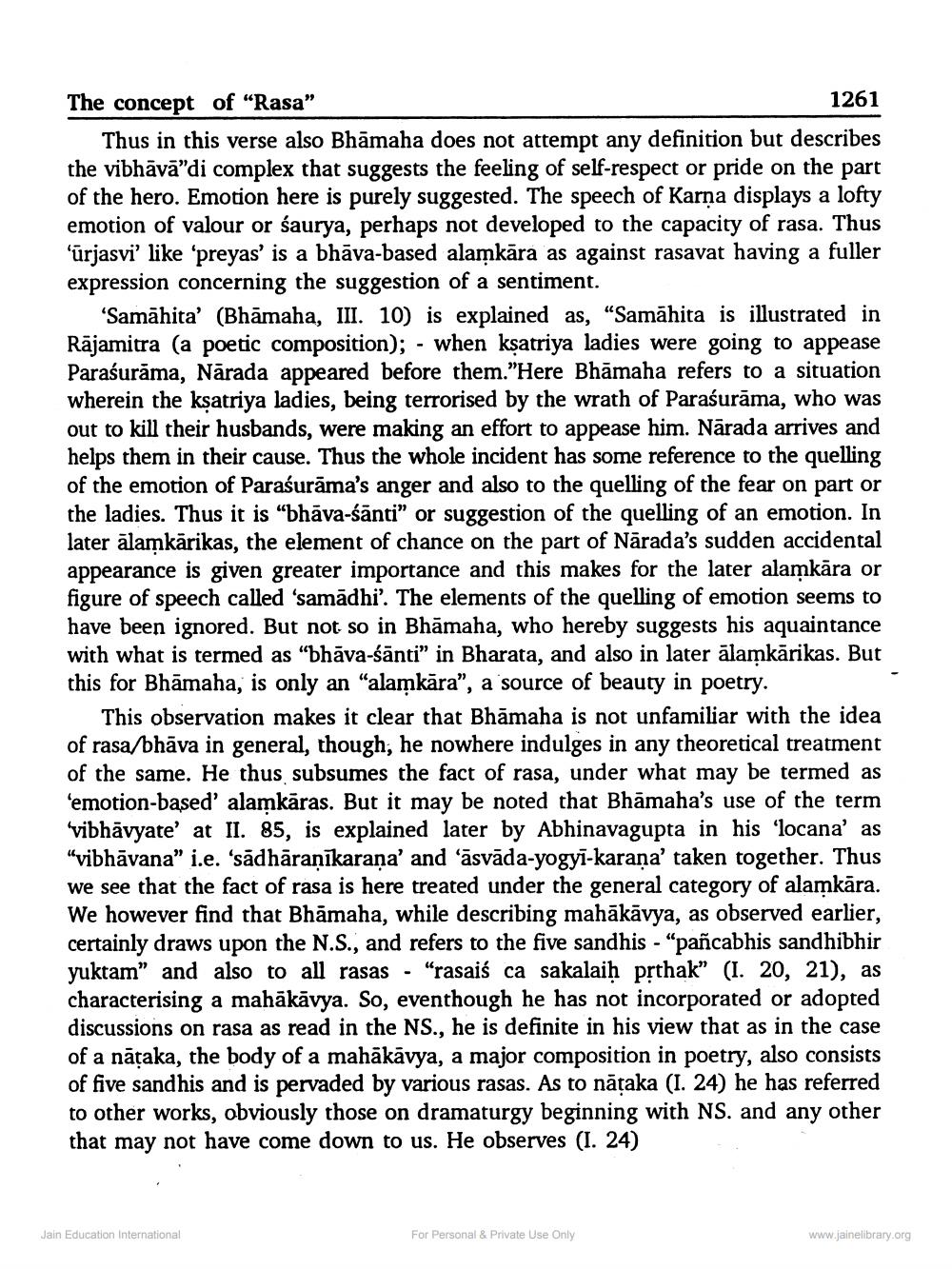________________
The concept of “Rasa”
1261 Thus in this verse also Bhāmaha does not attempt any definition but describes the vibhāvā'di complex that suggests the feeling of self-respect or pride on the part
notion here is purely suggested. The speech of Karna displays a lofty emotion of valour or śaurya, perhaps not developed to the capacity of rasa. Thus 'ūrjasvi' like 'preyas' is a bhāva-based alamkāra as against rasavat having a fuller expression concerning the suggestion of a sentiment.
'Samāhita' (Bhāmaha, III. 10) is explained as, “Samāhita is illustrated in Rājamitra (a poetic composition); - when ksatriya ladies were going to appease Paraśurāma, Nārada appeared before them."Here Bhāmaha refers to a situation wherein the ksatriya ladies, being terrorised by the wrath of Paraśurāma, who was out to kill their husbands, were making an effort to appease him. Nārada arrives and helps them in their cause. Thus the whole incident has some reference to the quelling of the emotion of Paraśurāma's anger and also to the quelling of the fear on part or the ladies. Thus it is "bhāva-śānti" or suggestion of the quelling of an emotion. In later ālamkārikas, the element of chance on the part of Nārada's sudden accidental appearance is given greater importance and this makes for the later alamkāra or figure of speech called 'samadhi'. The elements of the quelling of emotion seems to have been ignored. But not so in Bhāmaha, who hereby suggests his aquaintance with what is termed as "bhāva-śānti" in Bharata, and also in later alamkārikas. But this for Bhāmaha, is only an "alamkāra", a source of beauty in poetry.
This observation makes it clear that Bhāmaha is not unfamiliar with the idea of rasa bhāva in general, though, he nowhere indulges in any theoretical treatment of the same. He thus subsumes the fact of rasa, under what may be termed as 'emotion-based' alamkāras. But it may be noted that Bhāmaha's use of the term 'vibhāvyate' at II. 85, is explained later by Abhinavagupta in his 'locana' as "vibhāvana" i.e. 'sādhāraṇīkarana' and 'āsvāda-yogyi-karana' taken together. Thus we see that the fact of rasa is here treated under the general category of alamkāra. We however find that Bhämaha, while describing mahākāvya, as observed earlier, certainly draws upon the N.S., and refers to the five sandhis - "pañcabhis sandhibhir yuktam" and also to all rasas - "rasaiś ca sakalaih prthak” (I. 20, 21), as characterising a mahākāvya. So, eventhough he has not incorporated or adopted discussions on rasa as read in the NS., he is definite in his view that as in the case of a nāțaka, the body of a mahākāvya, a major composition in poetry, also consists of five sandhis and is pervaded by various rasas. As to nāraka (I. 24) he has referred to other works, obviously those on dramaturgy beginning with NS. and any other that may not have come down to us. He observes (I. 24)
Jain Education International
For Personal & Private Use Only
www.jainelibrary.org




